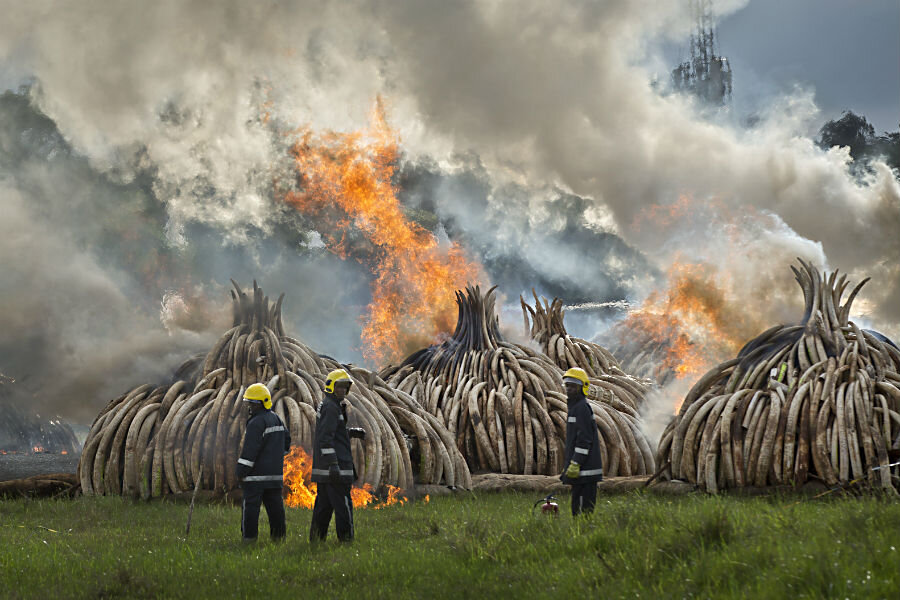Why Kenya burned 11 giant piles of ivory tusks
Loading...
| Nairobi, Kenya
Kenya's president set fire Saturday to 105 tons of elephant ivory and more than 1 ton of rhino horn, believed to be the largest stockpile ever destroyed, in a dramatic statement by this East African country against the trade in ivory and products from endangered species.
Uhuru Kenyatta put a flame to the biggest of 11 pyres of ivory tusks and one of rhino horn in a chilly afternoon. Overnight torrential rains had threated to ruin the event but stopped midday leaving a mud field around the piles inside Nairobi National Park.
"A time has come when we must take a stand and the stand is clear ... Kenya is making a statement that for us ivory is worthless unless it is on our elephants," Kenyatta said.
The stacks of tusks represent more than 8,000 elephants and some 343 rhinos slaughtered for their ivory and horns, according to the Kenya Wildlife Service.
Kenya will push for the total ban on trade in ivory at the 17th meeting of the Convention on International Trade of Endangered Species to be held in South Africa later this year, said Kenyatta.
The pyres were fueled with about 20,000 liters of jet fuel and oxygen, said Robin Hollister, the event's fire master, as a thick plume of white smoke billowed over the yellow flames consuming the ivory. Hollister earlier said it's not known how long the fire will take because the burning of such a quantity is unprecedented.
Kenya decided to destroy the ivory instead of selling it for an estimated $150 million. Some critics had suggested that the money raised from the ivory sales could be used to develop Kenya and protect wildlife. But Kenyatta said that Kenya wants to make the point that ivory should not have any commercial value.
Others said the burning will not end the killing of elephants because international gangs take advantage of Kenya's porous borders and corruption to continue the illegal trade.
The Christian Science Monitor reports that the symbolic burn has critics:
The measure has its critics, however, ranging from those who contend that the burning will raise the prices of the commodity, to those who say thatsuch an action demonstrates that elephants aren’t valued. Indeed some of the conservationists opposing the move have warned that it may backfire.
“Kenya is making a mistake, it’s an unwise move,” Mike Norton-Griffiths, a Kenyan ecologist told Bloomberg in an interview. “Taking such a huge resource completely off the market may in turn back the drop in prices.”
Another way to go, say some elephant advocates, would be to sell the stockpile to raise money for conservation. But the Kenyan government argues that putting the ivory on the market, though meant for a good cause,will strengthen the very black market it is seeking to destroy. Mr. Leakey told the Scientific American that the surge in ivory prices in the years after the 1989 ban was partly due to the fact that countries including South Africa, Botswana, Namibia, Zimbabwe put recovered ivory on the market.
Kenya Wildlife Service chairman and renowned paleoanthropologist and conservationist Richard Leakey said the burning of the ivory should encourage African countries to support a ban in ivory trade. He said a group of countries which is advocating for the sale of ivory in the continent should be ashamed.
"We will burn ivory and we hope every country in the globe will support Kenya and say never again should we trade ivory," Leakey said.
Africa had 1.3 million elephants in the 1970s but has only 500,000 today.
The elephant populations worst hit by poaching are in Tanzania, Gabon, Cameroon, Central African Republic, Mozambique, Republic of Congo and Congo. The years 2011, 2012 and 2013 witnessed the highest levels of poaching since a poaching crisis in the 1980s, according to Kenya's Wildlife Service.
Cameroon said it burned over 3.5 tons of tusks earlier in April as a statement against poaching.
Central Africa's forest elephants have declined by two-thirds between 2002 and 2012. Most of the remaining forest elephants are in Gabon and are under threat from armed groups, said Gabon's President Ali Bongo Ondimba, who attended Saturday's burning. He vowed to stop the decline of the species.
"To all the poachers, to all the buyers and foreign traders, your days are numbered," said Ondimba. "We are going to put you out of business and the best thing to do is to retire now."







